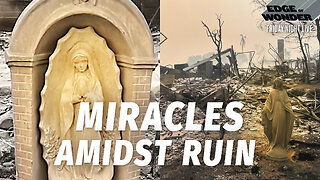Premium Only Content

New Continent likely to form in Africa
Although the expected big split is not likely to happen in our lifetime, the impacts are showing. Ever since the volcanic eruption in 2005, Afar has transformed dramatically. The desert has fissures packed with molten rock that has cooled down.
Thanks to advanced satellite data, scientists can now see clear signs of this transition taking place. You see, as the tectonic plates peel apart, material from deep inside the Earth starts to move up to the surface and form oceanic crusts in the ridges.
This is a treat since most of these things happen in the sea, making researchers have a hard time observing it. But thanks to the fissure in the Afar desert, they can learn more about tectonic plate movements.
Birth of a new ocean: University of Bristol seismologist Dr. James Hammond has been working in Afar desert. He says that parts of the area are below sea level and the ocean is just blocked by a 20-meter block of land in Eritrea.
If the ocean manages to flood in the fissures, this will start to create a new ocean. The flooding will sink down and pull apart some parts of Ethiopia. They have estimated that Somalia and some parts of southern Ethiopia would drift off and become islands of the Indian Ocean.
-
 LIVE
LIVE
Glenn Greenwald
1 hour agoThe Future of Gaza With Abubaker Abed; Journalist Sam Husseini On His Physical Expulsion From Blinken’s Briefing & Biden’s Gaza Legacy | System Update #391
2,556 watching -
 LIVE
LIVE
Roseanne Barr
4 hours agoWe are so F*cking Punk Rock! with Drea de Matteo | The Roseanne Barr Podcast #83
1,595 watching -
 1:04:58
1:04:58
In The Litter Box w/ Jewels & Catturd
1 day agoNo Tax On Tips! | In the Litter Box w/ Jewels & Catturd – Ep. 722 – 1/17/2025
108K26 -
 5:35:39
5:35:39
Dr Disrespect
9 hours ago🔴LIVE - DR DISRESPECT - WARZONE - CRAZY CHALLENGES
139K29 -
 LIVE
LIVE
Edge of Wonder
4 hours agoLA Fire Updates: Miracles Amidst the Devastation
548 watching -
 DVR
DVR
LFA TV
8 hours agoBanning Mystery of the Ages | TRUMPET DAILY 1.17.25 7pm
4.1K1 -
 LIVE
LIVE
2 MIKES LIVE
2 hours ago2 MIKES LIVE #168 Open Mike Friday!
230 watching -
 1:05:11
1:05:11
Sarah Westall
3 hours agoMysterious Fog and California Wildfires Both Contain Dangerous Elements w/ Dr Robert Young & Hazen
6.64K2 -
 DVR
DVR
Mally_Mouse
2 hours agoLet's Play!! -- Stardew Valley pt. 23!
11.3K -
 16:21
16:21
China Uncensored
5 hours agoCan Anything Stop the Tiktok Ban?
26.4K9